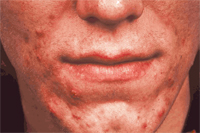 People with moderate acne or moderately-severe acne have a denser collection of whiteheads and blackheads ("comedones") than those with mild acne. There are also red and inflamed areas of the skin with pus-filled lesions (pustules).
People with moderate acne or moderately-severe acne have a denser collection of whiteheads and blackheads ("comedones") than those with mild acne. There are also red and inflamed areas of the skin with pus-filled lesions (pustules).
Bacteria called Propionibacterium acnes (P. acnes) causes the inflammation seen with moderate acne. P. acnes normally lives on the surface of the skin, but it can enter the comedones and infect the oily substance called "sebum" within the clogged pores. This causes the skin to become swollen, red, and painful.
Moderately severe acne usually requires treatment with one or more prescription acne medications, or procedures.
There are several prescription acne medications that have been shown to be effective for the treatment of moderate acne, including:
- Topical retinoids (applied to the skin), such as Differin® (adapalene), Epiduo® (adapalene + benzoyl peroxide), Retin A Micro® (tretinoin), Tazorac® (tazarotene), or Ziana® (tretinoin + clindamycin).
- Topical antibiotics (applied to the skin), such as clindamycin, or erythromycin.
- Oral antibiotics (taken by mouth), such a doxycycline or minocycline (Solodyn®).
- Oral contraceptives
Early treatment of moderate acne is recommended because of the risk of developing permanent acne scars. (Though the risk of developing acne scars is greater for people with severe acne).
Whatever acne medication you use, it is important that you give it enough time to work. This may require waiting 6 to 8 weeks to see results. While the older acne lesions are healing, the medicine is hard at work keeping new acne lesions from forming. Staying on your acne medication is the most important step to getting your acne under control.
Source: Vivacare
Last updated : 2/8/2021